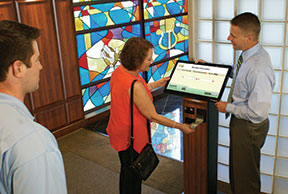By Doug Braun
Among the newer technologies transforming American churches is the digital giving kiosk — a freestanding unit that enables individuals to submit tithes or make freewill offerings at any time, using several forms of payment. Kiosks should also offer accounting and reporting features.
 While multifunctional kiosks can drive expanded giving and greater participation in the life of the church, they can also be met with resistance from members of the congregation. To that end, we propose a three-step introduction program.
While multifunctional kiosks can drive expanded giving and greater participation in the life of the church, they can also be met with resistance from members of the congregation. To that end, we propose a three-step introduction program.
Step 1: The pre-sell. The best starting point is to make sure all the system’s benefits and advantages are articulated to those with the ability to influence and authorize the purchase. Whether it’s a technology committee or the church board, it’s critical that these individuals aren’t just supportive, but excited! Enlist this group to help you inform and energize church staff, committees and church leaders — even before your kiosk arrives.
Anticipation is a powerful marketing tool, so think about including “coming soon” announcements in the newsletter, on posters in common areas, or by way of a mention during the news-and-notes portion of the worship service.
inLighten Sales Advisor Ryan Hardie, who consults with congregations on technology implementation, suggests using digital signage to get the message out. “Flat-screen TVs in church coffee shops or community rooms can be very effective in making people eager to know more about your digital giving kiosk,” he says. “Once your kiosk is in place, you can add current news and information to your digital signage program to ensure the system will serve as a constant reminder.”
David Tomb, administrative pastor at Community Church of Joy (Glendale, AZ), says his church uses its website to communicate its kiosk as a convenient and secure way to give. “That has really helped build awareness.”
Step 2: The buy-in. When your kiosk is first installed, it’s critical to have a very visible group of early adopters — even if some of them are technology-adverse. Arrange for presentations and tutorials to your board of elders and deacons, as well as to chairpersons and members of various committees. Emphasize the roles they can play — by their own example, in encouraging others to try the kiosk, and by offering assistance if asked.
Marketing by endorsement is a time-honored and successful strategy. It can make the difference between cautious curiosity and eager acceptance. Emphasize to your “introduction team” that acceptance is a long-term prospect, and you’ll want them to continue their practice of using the kiosk— and helping others discover its advantages, as well.
Step 3: The sell-through. The last step in the process is to make personal assistance available to those who need it. You’ll want friendly, helpful, tactful individuals on hand to introduce first-time and new users to all the features the kiosk offers, and to guide them through the operations they want to perform.
Recruit a group of volunteers for this service, and make sure they’re trained well on all the kiosk’s capabilities.
Their goal should be to make those they assist feel comfortable with the kiosk so that using it eventually becomes second nature.
Keep your giving kiosk top-of-mind
To maintain continual awareness of your giving kiosk, use it for more than just giving. An expanded set of utilities — onscreen messaging enablement in idle mode, providing access to the church website, or enabling event registration for events, for example — gives members and visitors more reasons to interact with the kiosk.
Doug Braun is senior vice president for sales and marketing at Clarence, NY-based inLighten, Inc. [inlighten.net], a leading provider of digital communication and self-service products. Braun has served his congregation as both a deacon and an elder.


